Dyes in History and Archaeology is a refereed, annual journal
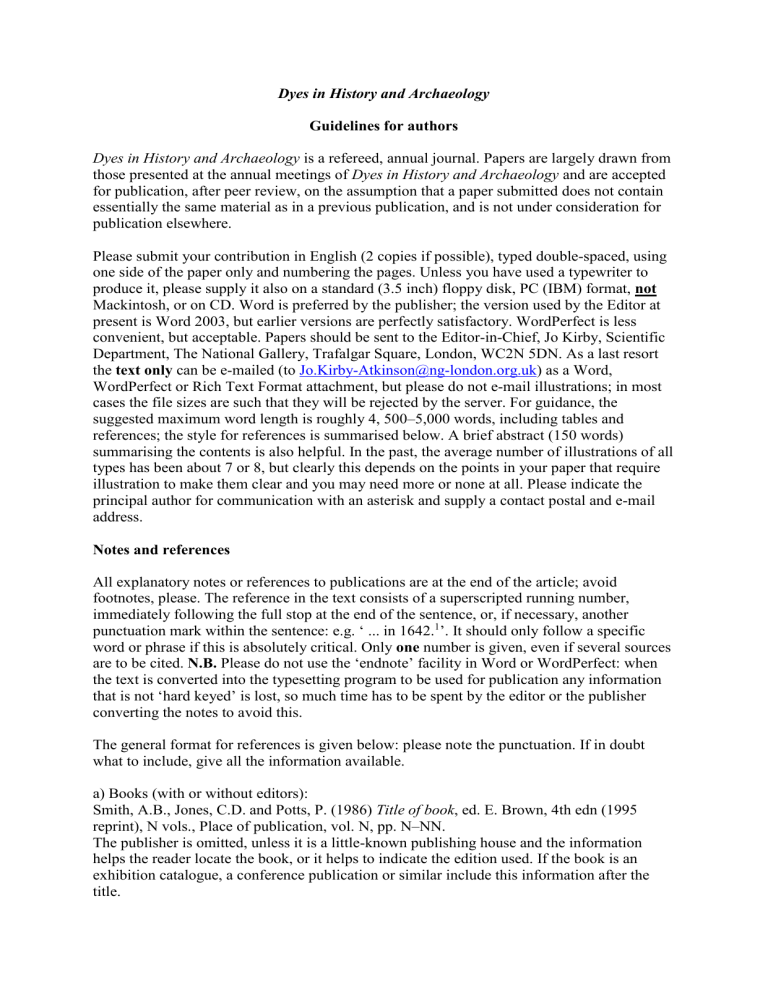
Dyes in History and Archaeology
Guidelines for authors
Dyes in History and Archaeology is a refereed, annual journal. Papers are largely drawn from those presented at the annual meetings of Dyes in History and Archaeology and are accepted for publication, after peer review, on the assumption that a paper submitted does not contain essentially the same material as in a previous publication, and is not under consideration for publication elsewhere.
Please submit your contribution in English (2 copies if possible), typed double-spaced, using one side of the paper only and numbering the pages. Unless you have used a typewriter to produce it, please supply it also on a standard (3.5 inch) floppy disk, PC (IBM) format, not
Mackintosh, or on CD. Word is preferred by the publisher; the version used by the Editor at present is Word 2003, but earlier versions are perfectly satisfactory. WordPerfect is less convenient, but acceptable. Papers should be sent to the Editor-in-Chief, Jo Kirby, Scientific
Department, The National Gallery, Trafalgar Square, London, WC2N 5DN. As a last resort the text only can be e-mailed (to Jo.Kirby-Atkinson@ng-london.org.uk
) as a Word,
WordPerfect or Rich Text Format attachment, but please do not e-mail illustrations; in most cases the file sizes are such that they will be rejected by the server. For guidance, the suggested maximum word length is roughly 4, 500–5,000 words, including tables and references; the style for references is summarised below. A brief abstract (150 words) summarising the contents is also helpful. In the past, the average number of illustrations of all types has been about 7 or 8, but clearly this depends on the points in your paper that require illustration to make them clear and you may need more or none at all. Please indicate the principal author for communication with an asterisk and supply a contact postal and e-mail address.
Notes and references
All explanatory notes or references to publications are at the end of the article; avoid footnotes, please. The reference in the text consists of a superscripted running number, immediately following the full stop at the end of the sentence, or, if necessary, another punctuation mark within the sentence: e.g. ‘ ... in 1642.
1 ’. It should only follow a specific word or phrase if this is absolutely critical. Only one number is given, even if several sources are to be cited. N.B.
Please do not use the ‘endnote’ facility in Word or WordPerfect: when the text is converted into the typesetting program to be used for publication any information that is not ‘hard keyed’ is lost, so much time has to be spent by the editor or the publisher converting the notes to avoid this.
The general format for references is given below: please note the punctuation. If in doubt what to include, give all the information available. a) Books (with or without editors):
Smith, A.B., Jones, C.D. and Potts, P. (1986) Title of book , ed. E. Brown, 4th edn (1995 reprint), N vols., Place of publication, vol. N, pp. N–NN.
The publisher is omitted, unless it is a little-known publishing house and the information helps the reader locate the book, or it helps to indicate the edition used. If the book is an exhibition catalogue, a conference publication or similar include this information after the title.
Examples:
Boltz, V. (1913) Illuminierbuch: wie man allerlei Farben bereiten, mischen und auftragen soll (Basel 1549), ed. C.J. Benziger, Munich (repr. Schaan, 1982), pp. 16–18.
Brunello, F. (1973) The Art of Dyeing in the History of Mankind, transl. B. Hickey, Vicenza, pp. 25–38.
Cardon, D. and du Chatenet, G. (1990) Guide des teintures naturelles , Paris-Lausanne, pp.
146–51.
Thomson, R.H. (1971) Naturally Occurring Quinones , 2nd edn, London, pp. 464–7.
Milanesi, G. (ed.) (1854)
Documenti per la storia dell’arte senese, I, Secoli XIII e XIV
, Siena, pp. 11–14. b) Articles in conference proceedings, catalogues and similar publications
Smith, A.B., Jones, C.D. and Potts, P. (1992) ‘Title of article’, in E. Brown and Q.R. Green
(eds), Title of book , N vols., Place of publication, vol. N, pp. N–NN.
(It is not essential to give the number of volumes unless the pagination begins at 1 in each volume.)
Examples:
Roy, A. and Berrie, B.H. (1998) ‘A new lead-based yellow in the seventeenth century’, in A.
Roy and P. Smith (eds), Painting Techniques: History, Materials and Studio Practice;
Contributions to the Dublin Congress of the International Institute for Conservation, 7–11
September 1998 , London, pp. 160–5.
Schweppe, H. (1986) ‘Identification of dyes in historic textile materials’, in H.L. Needles and
S.H. Zeronian (eds), Historic Textile and Paper Materials. Conservation and
Characterization (American Chemical Society Advances in Chemistry Series 212),
Washington, D.C., pp. 153–74. c) Publication by committee, government departmental report, etc.: no author or editor
Example:
Commission Internationale de l’Eclairage (1978) ‘Recommendations on uniform color spaces, color difference equations, psychometric color terms’, Supplement No.2 to CIE
Publication No.15 (E-2.3.1), 1971/(TC-1.3). d) Papers, articles in journals
Smith, A.B., Jones, C.D. and Potts, P. (1982) ‘Title of article’, Title of Journal 14, 3, pp. N–
NN.
If applicable insert the series number, or NS (new series), before the volume number. The part or issue number is helpful, and essential if the numbering of each part begins at 1. If the month is given rather than a number give this in parentheses: 14 (March), pp.N–NN. Please give the complete range of pages, adding ‘especially p. X’ if necessary.
Examples:
Quye, A. and Wouters, J. (1992) ‘An application of HPLC to the identification of natural dyes’,
Dyes in History and Archaeology 10, pp. 48–54.
Wouters, J. and Verhecken, A. (1991) ‘High-performance liquid chromatography of blue and purple indigoid natural dyes’,
Journal of the Society of Dyers and Colourists 107, 7–8, pp.
266–9, esp. p. 268 (example where part number cited).
Non-Roman alphabet references – books or journals – such as Arabic, Russian, Japanese,
Greek: cite the foreign text (e.g., journal title), transliterated, followed by the English in square brackets, e.g.
Hayashi, K., 1988, Shokubutu-Shikiso [Plant Pigments], Tokyo, p. 424.
Subsequent references to a publication are in the form:
Thomson 1971 (see note N above), p. 226.
Quye and Wouters 1992 (see note NN above), pp. 51–2.
For 3 or more authors give the first-named author and et al . If you cite several publications by
Smith and the same, or different, co-authors, all published in 1982 use 1982a, 1982b, etc.
Smith et al.
1982 (see note NNN abve).
Illustrations
Please include your illustrations – black and white or colour photographs, colour transparencies (35 mm or 5 x 4 inches), line diagrams and other camera-ready images – and their captions with your text. If text or any annotations are to be added to an image
(particularly to a photograph) please supply these as an overlay, NOT written on the image itself. In the case of machine-labelled chromatograms, spectra and so on, it is helpful if you also supply a duplicate print-out without labels. Illustrations will be reduced to fit into a column width (roughly 70 mm) or a page width (roughly twice this) and fine lines or annotations in small print on diagrams, such as chromatograms or spectra, which are to be scanned may not reproduce very well. If you do not have the final version of an illustration
(if, for example, it is on order from a library or museum) it would be helpful if you are able to provide some indication of what it will be. For illustrations submitted in electronic format, please supply a print-out on paper for guidance. When taking a photograph using a digital camera, or scanning an image, please ensure that the camera is on its highest quality setting, or scan at 300 dpi minimum: low quality small images are not suitable for reproduction. The current Archetype guidelines for digital illustrations can be downloaded as a pdf file at: http://www.chriscooksey.demon.co.uk/dha/journals.html
Illustration files may be submitted on CD or on floppy disk. If necessary the Editor will discuss file formats, resolution and so forth with the publishers. Please note that colour illustrations are expensive and it is entirely at the publisher’s discretion how many can be included; something you have submitted in colour may have to appear in black-and-white in the final volume. Colour illustrations may be produced together as a separate gathering in the volume, whereas black and white illustrations or line diagrams will be included in the main body of your article.
N.B.
Authors are responsible for obtaining permission to reproduce an illustration where this is necessary (if it has been supplied by some institution or from another publication, for example) and the caption should include any necessary wording required by the institution or body supplying it. The illustration will not be reproduced if this permission has not been obtained.
2.2006
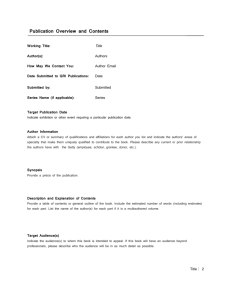
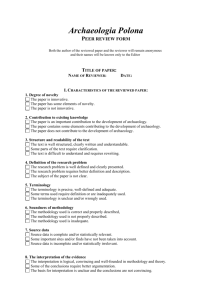


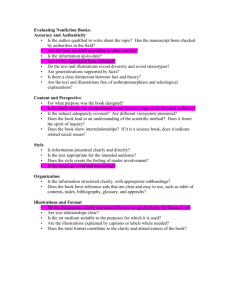
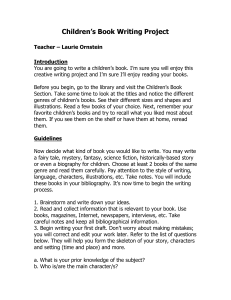
![Creating Worksheets [MS Word, 78 Kb]](http://s3.studylib.net/store/data/006854413_2-7cb1f7a18e46d36d8c2e51b41f5a82fa-300x300.png)
